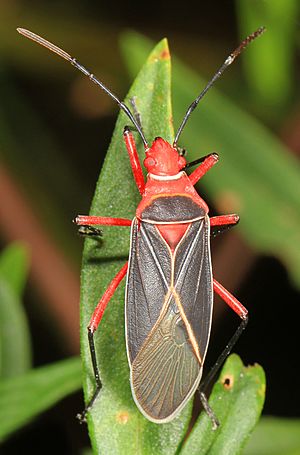Dysdercus suturellus facts for kids
Quick facts for kids Dysdercus suturellus |
|
|---|---|
 |
|
| Adult in Okaloacoochee Slough State Forest, Florida | |
| Scientific classification | |
| Genus: |
Dysdercus
|
| Species: |
suturellus
|
The Dysdercus suturellus is a type of true bug often called a cotton stainer. It belongs to the Pyrrhocoridae family. This insect is about 1 to 1.5 centimeters (about half an inch) long.
Adult cotton stainers have a red body and dark brown wings. These wings have a yellow cross-shaped mark. This bug is originally from the southeastern United States, Jamaica, and Puerto Rico. It is known as a pest because it feeds on cotton plants and other crops. Both adult bugs and older young bugs (nymphs) eat the developing cotton bolls and seeds.
Contents
What Does the Cotton Stainer Look Like?
The adult Dysdercus suturellus is usually about 1 to 1.5 centimeters long. It has a red head with black antennae. The first part of its antennae is longer than the second part.
Its body, called the thorax, is mostly red. It also has a white collar-like band. The underside of its body, called the abdomen, is red with white edges. The hard part of its wings is dark brown with cream-colored edges. This creates a large cross shape on its back.
Where Do Cotton Stainers Live and What Do They Eat?
The cotton stainer is native to the southeastern United States, Jamaica, and Puerto Rico. It is a common pest in cotton fields. Its presence is often linked to where cotton is grown.
Besides cotton, these bugs feed on many other plants. These include tangerines, okra, papaya, and oleander. They also like roselle, rose of Sharon, and Turk's cap mallow. Other host plants are teaweed, Caesarweed, Spanish needles, and Portia tree. They can also be found on roses, eggplant, black nightshade, and guava. All these plants belong to specific plant families like Malvaceae and Sterculiaceae.
Cotton Stainer Life Cycle
The Dysdercus suturellus is a true bug, so it does not go through a full metamorphosis like butterflies. Its life cycle has a few stages.
The eggs are pale yellow. Female bugs lay them one by one or in small groups. They usually lay eggs in sand, fallen leaves, or plant debris. The eggs hatch in about one week. The young bugs, called nymphs, then grow through five different stages. This takes about three to five weeks.
The first stage nymph lives underground. After that, it climbs onto a host plant. Nymphs are mostly red. In their later stages (fourth and fifth), their dark wing pads become visible and grow larger. The parts of their abdomen also develop pale edges, making them more noticeable. Several new generations of cotton stainers can be born each year.
How Cotton Stainers Affect Plants
Adult cotton stainers and older nymphs eat the protein-rich seeds of their host plants. Since seeds become available at different times, the winged adults fly between different plant types.
These bugs have also been seen eating the young forms (larvae) of the cotton leafworm. They also eat the larvae and pupae (resting stage) of the yellow scallop moth. Cotton stainers also feed on nectar from many flowers and various fruits, including citrus.
When these insects feed on cotton bolls, the young bolls might not grow properly. The cotton fibers inside can also get stained, which lowers the crop's value. If they feed on citrus fruits, they push their rostrum (a beak-like mouthpart) deep into the fruit. This can cause the fruit to fall off the tree or rot inside within a few days.

